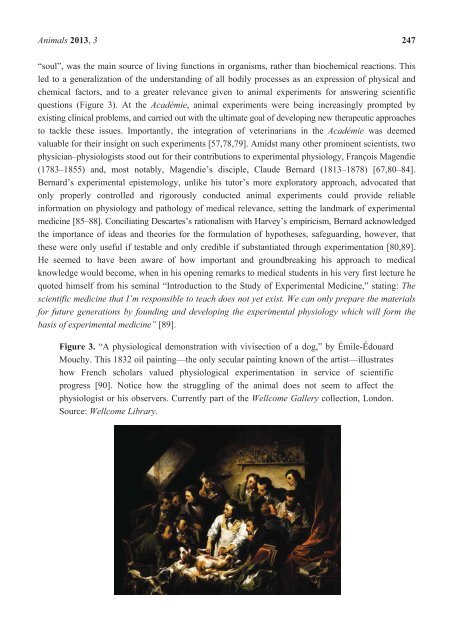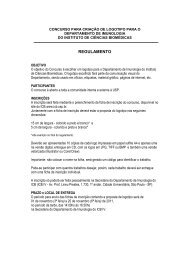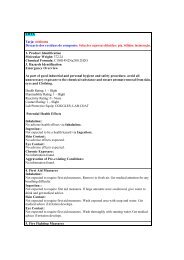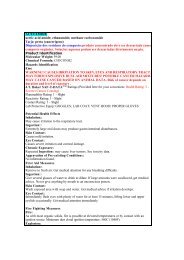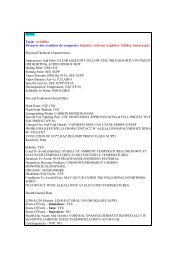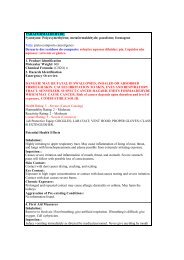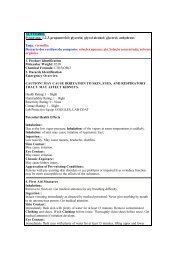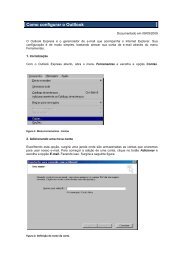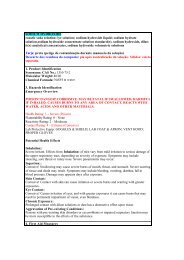<strong>Animal</strong>s 2013, 3 247“soul”, was the ma<strong>in</strong> source of liv<strong>in</strong>g functions <strong>in</strong> organisms, rather than biochemical reactions. Thisled to a generalization of the understand<strong>in</strong>g of all bodily processes as an expression of physical andchemical factors, and to a greater relevance given to animal experiments for answer<strong>in</strong>g scientificquestions (Figure 3). At the Académie, animal experiments were be<strong>in</strong>g <strong>in</strong>creas<strong>in</strong>gly prompted byexist<strong>in</strong>g cl<strong>in</strong>ical problems, and carried out with the ultimate goal of develop<strong>in</strong>g new therapeutic approachesto tackle these issues. Importantly, the <strong>in</strong>tegration of veter<strong>in</strong>arians <strong>in</strong> the Académie was deemedvaluable for their <strong>in</strong>sight on such experiments [57,78,79]. Amidst many other prom<strong>in</strong>ent scientists, twophysician–physiologists stood out for their contributions to experimental physiology, François Magendie(1783–1855) and, most notably, Magendie’s disciple, Claude Bernard (1813–1878) [67,80–84].Bernard’s experimental epistemology, unlike his tutor’s more exploratory approach, advocated thatonly properly controlled and rigorously conducted animal experiments could provide reliable<strong>in</strong>formation on physiology and pathology of medical relevance, sett<strong>in</strong>g the landmark of experimentalmedic<strong>in</strong>e [85–88]. Conciliat<strong>in</strong>g Descartes’s rationalism with Harvey’s empiricism, Bernard acknowledgedthe importance of ideas and theories for the formulation of hypotheses, safeguard<strong>in</strong>g, however, thatthese were only useful if testable and only credible if substantiated through experimentation [80,89].He seemed to have been aware of how important and groundbreak<strong>in</strong>g his approach to medicalknowledge would be<strong>com</strong>e, when <strong>in</strong> his open<strong>in</strong>g remarks to medical students <strong>in</strong> his very first lecture hequoted himself from his sem<strong>in</strong>al “Introduction to the Study of Experimental Medic<strong>in</strong>e,” stat<strong>in</strong>g: Thescientific medic<strong>in</strong>e that I’m responsible to teach does not yet exist. We can only prepare the materialsfor future generations by found<strong>in</strong>g and develop<strong>in</strong>g the experimental physiology which will form thebasis of experimental medic<strong>in</strong>e” [89].Figure 3. “A physiological demonstration with vivisection of a dog,” by Émile-ÉdouardMouchy. This 1832 oil pa<strong>in</strong>t<strong>in</strong>g—the only secular pa<strong>in</strong>t<strong>in</strong>g known of the artist—illustrateshow French scholars valued physiological experimentation <strong>in</strong> service of scientificprogress [90]. Notice how the struggl<strong>in</strong>g of the animal does not seem to affect thephysiologist or his observers. Currently part of the Well<strong>com</strong>e Gallery collection, London.Source: Well<strong>com</strong>e Library.
<strong>Animal</strong>s 2013, 3 248From the 1830s and throughout the second half of the century, the concept of scientific medic<strong>in</strong>ewould also flourish amidst a dist<strong>in</strong>ct group of German/Prussian physiologists. Follow<strong>in</strong>g the rationalethat biology could be understood through the means of chemistry and physics, and through theirpivotal animal experiments and the use of microscopy, these scientists vastly contributed to thedevelopment of anatomy, histology, pathology, embryology, neurophysiology, physiology and physics.The sett<strong>in</strong>g for this scientific and epistemological progress was the Anatomisches Museum <strong>in</strong> Berl<strong>in</strong>,where anatomist, zoologist, and physiologist Johannes Müller (1801–1858) offered workspace andsupervision to brilliant students whose <strong>in</strong>dependent research he wished to encourage. Although lack<strong>in</strong>gthe money, space, and <strong>in</strong>struments available <strong>in</strong> the great German laboratories founded after 1850, themuseum provided these young scientists—notably Theodor Schwann (1810–1882), Robert Remak(1815–1865), and Friedrich Henle (1809–1885) <strong>in</strong> the 1830s, and Carl Ludwig (1816–1895), Emil duBois-Reymond (1818–1896), Ernst Brücke (1819–1892), Hermann von Helmholtz (1821–1894), andRudolph Virchow (1821–1902) <strong>in</strong> the 1840s—a s<strong>in</strong>gular <strong>in</strong>tellectual atmosphere for research.Henle and Virchow would be<strong>com</strong>e leaders of the 1840s’ medical revolution <strong>in</strong> Germany, promot<strong>in</strong>gthe reform of medic<strong>in</strong>e by provid<strong>in</strong>g it with a scientific basis, while Brücke, Helmholtz, andBois-Raymond’s focused on the development of physiology as an autonomous science [83,91–95].Their contributions to medical knowledge through the n<strong>in</strong>eteenth century, along with Magendie’s andBernard’s pivotal works, would deeply <strong>in</strong>fluence their counterparts across the Western world <strong>in</strong> thelatter decades of the n<strong>in</strong>eteenth century. Thousands of students flocked to attend medical schools<strong>in</strong> Germanic universities (and French <strong>in</strong>stitutes, although to a lesser extent), many of them fromacross the Atlantic [85,88,91,96,97]. This, <strong>in</strong> turn, would lead to an unprecedented rise <strong>in</strong> animalresearch-based advancement <strong>in</strong> biological and medical knowledge <strong>in</strong> the late n<strong>in</strong>eteenth century—withimportant consequences for public health and quality of life—as further discussed later <strong>in</strong> this text.While the second half of the n<strong>in</strong>eteenth century marked the beg<strong>in</strong>n<strong>in</strong>g of scientifically mean<strong>in</strong>gfuland medically relevant animal research, this period also saw opposition to vivisection be<strong>com</strong><strong>in</strong>g amore widespread idea <strong>in</strong> Europe, especially <strong>in</strong> Brita<strong>in</strong>. Although animal experiments were not yetregulated <strong>in</strong> the first half of the century, the development of British physiology research <strong>in</strong> theVictorian Era was los<strong>in</strong>g pace to Germany and France, where unprecedented progress <strong>in</strong> medicalknowledge was tak<strong>in</strong>g place. The openly antivivisectionist positions of <strong>in</strong>fluential jurists, politicians,literary figures, clergymen, dist<strong>in</strong>guished members of the medical <strong>com</strong>munity, and even Queen Victoria,contributed to an unfriendly environment for animal-based medical research [90,91]. There was,however, also a matter of divergence of op<strong>in</strong>ion between British anatomists and French physiologistson which was the best approach for obta<strong>in</strong><strong>in</strong>g medical knowledge. Tak<strong>in</strong>g advantage of the ris<strong>in</strong>gantivivisection trend, British anatomists explored the (undoubted) gruesomeness of Magendie’sexperiments, along with some nationalistic partisanship and xenophobic feel<strong>in</strong>gs aga<strong>in</strong>st France, <strong>in</strong>their defense of anatomical observation as the primary method for advanc<strong>in</strong>g physiology, to thedetriment of experiment through vivisection. However, they seldom disclosed their own positive (or atleast ambivalent) views on animal experiments as a means to corroborate f<strong>in</strong>d<strong>in</strong>gs achieved throughanatomical exploration [90,98,99]. Magendie would be<strong>com</strong>e the arch-villa<strong>in</strong> of the antivivisectionmovement. Despite the broad recognition of his contributions to science by most peers, he was alsoamongst the most <strong>in</strong>famous of his time for the disda<strong>in</strong> he held for his experimental subjects. Thiscontestation was louder outside of France, where many of his fellow scientists, even those who
- Page 6 and 7: Animals 2013, 3 243Amidst the list
- Page 8 and 9: Animals 2013, 3 245Nevertheless, th
- Page 13 and 14: Animals 2013, 3 250experiments that
- Page 15 and 16: Animals 2013, 3 252Just like today,
- Page 17 and 18: Animals 2013, 3 254Figure 4. This f
- Page 19 and 20: Animals 2013, 3 256was awarded, whi
- Page 21 and 22: Animals 2013, 3 258hedonistic utili
- Page 24: Animals 2013, 3 261philosopher Raym
- Page 27 and 28: Animals 2013, 3 26414. Rupke, N.A.
- Page 29 and 30: Animals 2013, 3 26655. Porter, R. T
- Page 31 and 32: Animals 2013, 3 26895. Otis, L. Joh
- Page 33 and 34: Animals 2013, 3 270135. Linton, D.S
- Page 35 and 36: Animals 2013, 3 272175. Rollin, B.E


